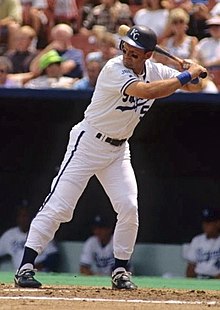Pine Tar Incident
With his team trailing 4–3 in the top half of the ninth inning and two out, the Royals' future Hall of Fame third baseman George Brett hit a two-run home run off future Hall of Fame Yankee closer Rich "Goose" Gossage to give his team the lead; however, Yankee manager Billy Martin, who had noticed a large amount of pine tar[3] on Brett's bat, requested that the umpires inspect his bat.
With U L Washington on first base George Brett came to the plate and reliever Dale Murray was replaced by closer Rich "Goose" Gossage.
After fouling off the first pitch to the left, Brett connected on a high strike and put it well into the right field stands for a two-run home run and a 5–4 lead.
[11] Yankees third baseman and captain Graig Nettles recalled a similar incident involving Thurman Munson in a 1975 game against the Minnesota Twins.
With Brett watching from the dugout, McClelland and the rest of the umpiring crew, Drew Coble, Joe Brinkman, and Nick Bremigan, inspected the bat.
An enraged Brett leaped out of the dugout and confronted McClelland, requiring him to be physically restrained by his manager Dick Howser, several of his teammates, and crew chief Joe Brinkman.
In explaining his decision, MacPhail noted that the "spirit of the restriction" on pine tar on bats was based not on the fear of unfair advantage, but simple economics; any contact with pine tar would discolor the ball, render it unsuitable for play, and require that it be discarded and replaced—thus increasing the home team's cost of supplying balls for a given game.
MacPhail thus restored Brett's home run and ordered the game resumed with two outs in the top of the ninth inning with the Royals leading 5–4.
[15] That injunction was immediately appealed by the American League and was overturned by Supreme Court Appellate Division Justice Joseph Sullivan, who issued the extremely short and simple decision of "Play ball."
With Mattingly set to lead off the bottom of the ninth, the move allowed the substitution of another potent batter (Ken Griffey) to play first base, and made the Yankees' top starter available to pitch if needed, all while avoiding "wast[ing] a possible pinch hitter or runner.
[9] Frazier then threw to second, claiming that the base was touched by neither Brett nor U L Washington, the other player scoring on the home run, but umpire Dave Phillips, chief of the new crew, signaled safe.
[18] Martin went on the field to argue, and, anticipating just such a gambit, Phillips pulled out a notarized statement produced by MacPhail's administrative assistant Bob Fishel and signed by all four umpires from July 24 indicating that Brett had touched every base.
[23][24] Halper also acquired the signed business card of Justice Orest V. Maresca, who had issued the injunction, and the can of Oriole Pine Tar Brett had used on the bat.
Armstrong said in a 2006 interview that, as the Royals were leaving for the airport after the resumed game, an angry Yankees fan threw a brick from an overpass at Kansas City's bus, cracking its windshield.
In 1983, folk and "hillbilly" artist Red River Dave McEnery released "The Pine-Tarred Bat (The Ballad of George Brett)" on Longhorn Records.
[31] Country music artist C. W. McCall dedicated the 1985 song "Pine Tar Wars" to the event, composing a lyric that features an accurate[citation needed] telling of the relevant facts of the story.


